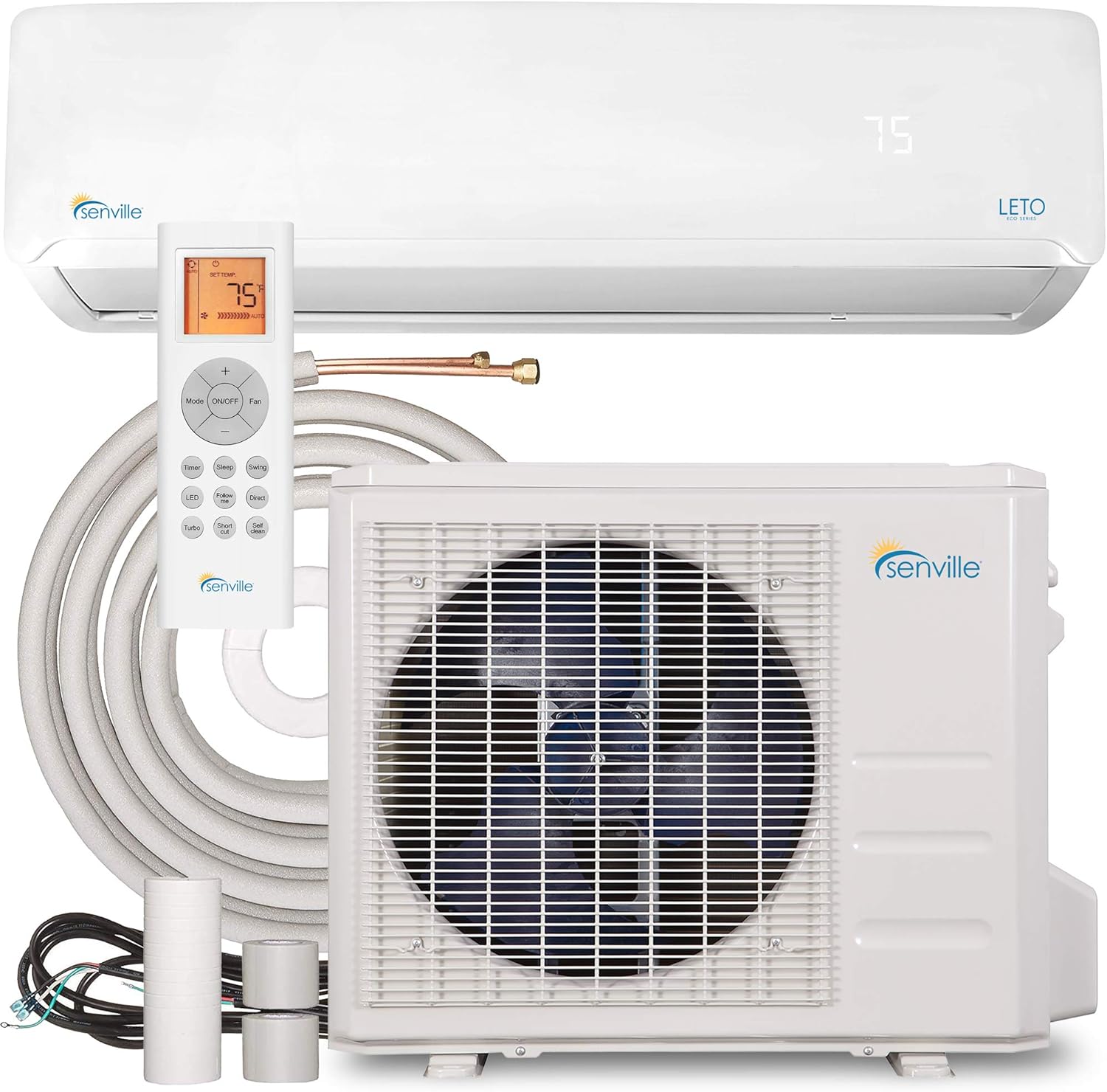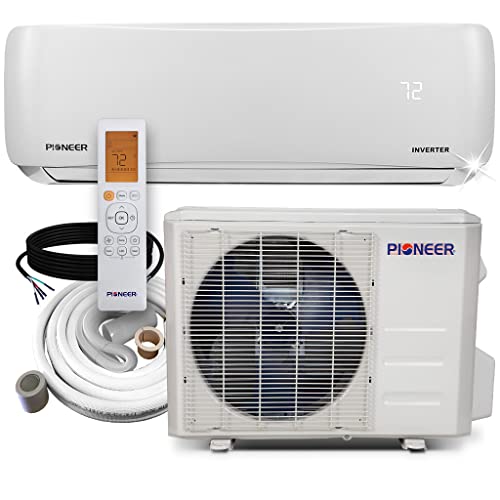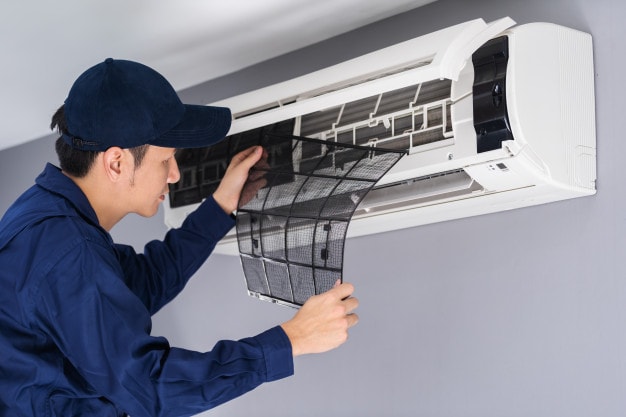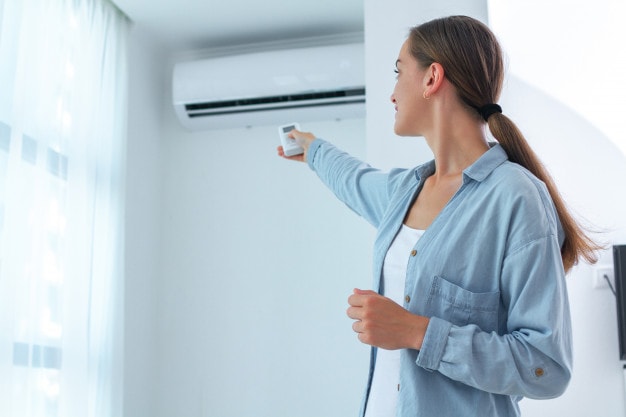Selecting an air conditioner (AC) for the home or office comes down to buying an inverter or non-inverter.
Do you know which are the best inverter ACs and which factors to look at before parting with your funds?
We review the top options on the market and give you some sage advice on how it works.
At a Glance: Our Top Picks for Inverter Air Conditioners
- OUR TOP PICK: Cooper & Hunter 20.5 SEER Mini Split
- RUNNER-UP: Daikin 17 SEER Mini Split
- BEST BUDGET OPTION: Senville SENL-12CD
Comparison of the Best Inverter Air Conditioners
| IMAGE | PRODUCT | |
|---|---|---|
Our Top Pick  |
| View Latest Price → |
 |
| View Latest Price → |
Best Budget Option  |
| View Latest Price → |
 |
| View Latest Price → |
 |
| View Latest Price → |
 |
| View Latest Price → |
 |
| View Latest Price → |
Factors to Consider Before Buying an Inverter Air Conditioner
You’ve decided to buy an inverter AC. Now that you’re ready to make your home more comfortable, here are a few factors to consider.
Room Size
The size of the room where you’ll install the AC unit is exceptionally significant. It’ll be challenging for a small inverter AC to cool or heat a massive room.
The opposite is also true. You don’t want an oversized AC for a small area. A 1.5-ton device can cover between 140 and 180 sq. ft., while you may need to go up to a 2-ton unit for larger spaces.
Air Quality
The ideal air quality provides you with comfort in your home. Ensure that the inverter AC can help reduce humidity while cooling your house. If it includes an air filter, make sure it can remove dust and other air particles from your home.

Cooling Capacity
If you’re living in a region with high temperatures, you’ll want to make sure that the inverter AC can bring it down. This measurement is displayed as British Thermal Units (BTU).
There are two fans, a thermostat, and variable speeds for different settings in the day. The best inverter ACs let you cool the air while not consuming too much power. For this measurement, you should look for the Seasonal Energy Efficiency Ratio (SEER).
Functions and Features
Not all inverter ACs are built the same. One of the top features to look out for is the Energy Star rating. It will ensure that the unit saves you as much power as possible, preventing you from spending your whole budget on the utility bill.
You should also see if it serves more than one purpose. While some inverter ACs can only cool, others have the additional function of heating. If you’re lucky, it can also auto-clean and diagnose itself for problems.
One more feature you should look for is an auto-restart function. If you suffer a power outage, the inverter AC will switch back on when the electricity is restored while retaining the previous settings.
Key Terms to Know
To help compare products in this review, we have included a few key specifications for each. Here is a quick summary of what they mean.
Type: Whether the AC is portable, window mounted, mini-split, central, evaporative, etc.
BTUs: British Thermal Unit (BTU) measures energy. This refers to the energy necessary to increase the temperature of one pound of water by one degree Fahrenheit.
Dimensions: The actual dimensions in l x w x h.
Weight: The physical weight of the air conditioner.
Voltage: The amount of electricity the unit uses. This determines the type of outlet it must plug into.
Coverage Area: The amount of square footage the unit can adequately cool, determined by the manufacturer.
Energy Efficiency Features: Whether the unit has any features or ratings relating to energy usage.
dB (decibel) Level: The amount of noise the AC produces when in operation.
Modes: The modes of operation the unit features. This includes dehumidification, fan only, cooling, etc.
Review of the Best Inverter Air Conditioners
Now that you understand what to look for, let’s take you through our list of the best inverter AC. Remember to find the one that suits you best, as you’ll need to live with the unit daily.
Best Overall:
Cooper & Hunter 20.5 SEER Mini Split

PROS
CONS
This Cooper & Hunter inverter AC is powerful enough to work in any spaces that average 850 sq ft. There are remote control and Wi-Fi application you can use to control the unit, letting you manage the 24,000 BTU from wherever you are.
One of the most considerable drawbacks is the instructions. While you don’t have to be a genius to understand them, some lengthy descriptions don’t clarify which specific tasks to perform.
However, the AC is exceptionally silent even in the highest settings. You’ll enjoy the range on the remote, while the unit can also combat extreme temperatures.
Bottom Line
Overall, the inverter AC has robust performance for hot and cold climates. Whether you need it at home or in your store, it’s capable of ventilating and dehumidifying the air.
If you’re looking for a silent running that can handle extremely low temperatures, this Cooper & Hunter inverter AC may just suit your needs.
Product Specs
Type:
Mini Split
BTUs:
24,000
Dimensions:
45 x 40 x 40"
Weight:
220 lbs
Voltage:
230
Coverage Area:
1,500 sq. ft
Energy Efficiency Features:
SEER: 20.5
dB (decibel) Level:
33 dB(A)
Modes:
Cool, Heat
Warranty:
5 years
Runner-up:
Daikin 17 SEER Mini Split
No products found.
PROS
CONS
If you’re into energy savings, you’ll be happy to know that this inverter AC has a SEER rating of 17. It can cover up to 400 sq. ft., which you can use in cold and hot rooms, basements, attics, living areas, and during renovations.
While the instruction manual leaves much to be desired, the most challenging aspect is getting the wiring between the split units sorted. Since the manufacturer warns against splicing, you need to be careful not to void the warranty.
The AC works like a heat pump system to regulate temperatures and ventilation. Included in the package are a wall bracket and an installation kit to make your life easier.
Bottom Line
Finding an AC that has low power consumption can be daunting. Fortunately, this Daikin unit can heat and cool your space with 19,000 BTU while being extremely lightweight.
You’ll also have a 10-year warranty on the parts, so be careful when installing or maintaining them.
Product Specs
Type:
Mini Split
BTUs:
9,000
Dimensions:
31 x 32 x 31"
Weight:
73 lbs
Voltage:
230
Coverage Area:
400 sq. ft
Energy Efficiency Features:
SEER: 17
dB (decibel) Level:
51 dB
Modes:
Cool, Heat
Warranty:
10 years
Best for the Money:
Senville SENL-12CD

PROS
CONS
While the 12,000 BTU is smaller than some of the other products on our list of the best inverter ACs, it delivers 294 CFM to promote airflow around your home. Besides ventilation, you’ll also have a dehumidification function to help reduce excess moisture in the air.
Although there’s an installation kit included in the package, you’ll need to watch several online videos to get a handle on putting everything together. It misses some significant explanations for how to complete steps, which may leave you frustrated.
If you’re living in a region that suffers from cold temperatures, the inverter AC can handle levels as low as 5 °F. You won’t need to worry about a loud hum in your house, thanks to Whisper Technology.
Bottom Line
This 12,000 BTU inverter AC will save you money in the long run due to its energy efficiency and low maintenance costs. Sure, you might need someone to help you install it, but it packs a powerful punch once it’s running.
You also can enjoy the silent performance while regulating airflow, temperatures, and humidity levels.
Product Specs
Type:
Mini Split
BTUs:
12,000
Dimensions:
26 x 10.43 x 21.26"
Weight:
66.14 lbs
Voltage:
110
Coverage Area:
450 sq. ft
Energy Efficiency Features:
SEER: 19
dB (decibel) Level:
28 dB
Modes:
Cool, Heat
Warranty:
2 years
Best Dual Inverter Air Conditioner:
LG LW1019IVSM
No products found.
PROS
CONS
One of the most outstanding features is the four-way air deflection. You can adjust which way the air blows into your space, whether left, right, up or down.
The LG LW1019IVSM inverter AC is extremely challenging to find in stores and online. While you can now purchase the dual inverter, you might struggle to find replacement components in the future.
You can adjust four different speeds using the remote control or the Wi-fi application for your smartphone. You can also monitor it while away from home to ensure that everything is running correctly.
Bottom Line
Since this dual inverter is best suited for window installations, you’ll need to make sure that your window frame is the correct size. Once installed, though, it delivers excellent performance for ventilation, cooling, and heating.
Of course, you won’t have to worry about it blowing on the back of your neck with the four-way deflection panels.
Product Specs
Type:
Window
BTUs:
9,500
Dimensions:
24.5 x 19.6 x 12.5"
Weight:
63 lbs
Voltage:
115
Coverage Area:
450 sq. ft
Energy Efficiency Features:
SEER: 13.8
dB (decibel) Level:
44 dB
Modes:
Cool, Energy Saver, Fan, Dry
Warranty:
1 year
Best Inverter Window Air Conditioner:
Midea U Inverter MAW08V1QWT
No products found.
PROS
CONS
The one aspect you’ll love about this Midea U inverter is the shape. The design lets you place it in single- and double-hung windows while also allowing for silent performance without the windows rattling.
Thanks to the installation kit and instructions, you’ll be placing it in your window frame within a couple of hours. However, the manual misses some vital points you may need to research, such as the pitch for the condensation drainage.
You can control the AC settings with your voice thanks to the Alexa app or the smartphone application also available for download. The 8,000 BTU unit is perfect for small areas, no matter what you’re using it for, such as living spaces and attics.
Bottom Line
This Midea inverter considers several factors. For instance, the design makes it optimal for most window frames, while there are brackets for the AC and remote control.
Of course, you can dispense with the latter with the voice and smartphone controls. If you’re out for the evening or on your way home, you can start preparing the AC from the comfort of your car.
Product Specs
Type:
Window
BTUs:
8,000
Dimensions:
21.97 x 19.17 x 13.46"
Weight:
67.9 lbs
Voltage:
115
Coverage Area:
400 sq. ft
Energy Efficiency Features:
Energy Star/ SEER 13.8
dB (decibel) Level:
42 dBA
Modes:
Cool, Fan, Dry, Sleep
Warranty:
1 year
Best Panasonic Inverter Air Conditioner:
Panasonic XE9SKUA



PROS
CONS
We know that the 8,000 BTU level may be pretty low and best suited for smaller homes, but the 470 CFM delivers high air circulation. It has a high SEER rating of 30.6, which means you’ll have low power consumption at optimal performance.
If you’re looking for an inverter AC that also helps reduce humidity, this unit has a capacity of 1.3 pints per hour. It’s a low amount and will only work effectively if you keep it running for most of the day.
On the plus side, you can use it in low temperatures up to -15°F. There’s a base-pan heater to ensure that no freezing occurs, while the sensor technology adjusts speeds based on the interior conditions.
Bottom Line
Panasonic is one of the industry’s leading brands, and it shows in their inverter AC. It has strong airflow for a small unit, delivering excellent ventilation and temperature control.
As additional features, you can also look forward to base-pan heating and sensor technology.
Product Specs
Type:
Mini Split
BTUs:
8,700
Dimensions:
12.63 x 68.73 x 27.83"
Weight:
121 lbs
Voltage:
208V to 230V
Coverage Area:
300 sq. ft
Energy Efficiency Features:
Energy Star / SEER 30.6 / EER 17.5 / HSPF 14.0
dB (decibel) Level:
42 dBA
Modes:
Cool, Heat, Auto, Dry, Fan
Warranty:
5 years
Best Pioneer Inverter Air Conditioner:
Pioneer WYS009A-19

PROS
CONS
This wall-mounted inverter AC has a ductless installation that includes a 16 ft. copper pipe kit. Thanks to the energy-efficiency, you won’t be spending so much on your monthly utility bills.
Unfortunately, Pioneer didn’t design it with low temperatures in mind. You may find it icing up during the first few weeks of winter if you live in a cold climate.
Be that as it may, you’ll still receive powerful airflow with adequate temperature controls. There’s a stunning remote control with numerous functions, including a wall unit and a digital screen that lights up when in use.
Bottom Line
Useful for heating and cooling, the silent AC will ventilate your home without waking you up in the middle of the night. You’ll enjoy free tech support from the manufacturer if something goes wrong or you need help with the installation. The sleek design won’t stick out on your wall, making it as good a decoration as it is at temperature control.
Product Specs
Type:
Mini Split
BTUs:
9,000
Dimensions:
28.5 x 7.5 x 11.5"
Weight:
76.28 lbs
Voltage:
110~120V
Coverage Area:
450 sq. ft
Energy Efficiency Features:
SEER: 19.5 / 9.5 HSPF
dB (decibel) Level:
55 dBA
Modes:
Cool, Heat
Warranty:
5 years
What Is an Inverter Air Conditioner and How Does an Inverter Air Conditioner Work?
Unlike standard AC units, an inverter AC uses the latest technology to regulate a room’s temperature. The inverter controls the compressor speed, which adjusts based on sensors or your remote control.
In effect, the direct current (DC) inverter consists of a variable-frequency drive with an electrical component that’s adjustable. It manages the electromotor’s speed in the compressor, which shifts how much cool or hot air it pushes out.
It does this by transforming the AC to DC, with a modulation in the inverter that delivers the desired frequency. In the end, it produces the correct airflow at the right temperature no matter how much the room changes.



Photo credit: daikinindia.com
Types of Inverter Air Conditioners
There isn’t only one inverter AC type. You’ll need to evaluate each one to see which suits your needs best. Here are the three primary types.
Mini-Split Air Conditioner
When a central AC is out of the question, and you’re looking for the ductless option, you’ll aim for the mini-split AC. The compressor is located outside, with the indoor evaporator installed as close to the ceiling as possible.
The evaporator performs the heating and cooling, while it may also act as a dehumidifier. The condensation drain is on the outside, which you can feed into your garden or a bucket with a cable.



Senville SENL-12CD Mini Split
Portable Air Conditioner
Existing as a single unit, the portable inverter AC has wheels that let you move it around the home. There are generally fewer functions available, but you can focus it on a single living space rather than the whole house.
There’s also the benefit of packing it up and taking it with you on holidays. Some people also use it in their motorhomes.
Window Air Conditioner
Some homeowners prefer inserting inverter ACs in window frames. The drainage goes outside while the output faces into the home.
You can purchase units with adjustable brackets for the extra spacing in the frames, while others require you to buy additional spacers.
Advantages of Inverter Air Conditioner
Owning an inverter AC has several benefits for your home and lifestyle. Let’s take a look at some of the top advantages.
Cost-Effective
When compared to installing a central air conditioning unit, you’ll save your budget by purchasing an inverter unit. The components are also more cost-effective to replace, significantly lowering your maintenance expenses.
Energy-Efficient



Of course, you’ll also want to save on your utility bills. Inverter ACs consume less power than standard units, as they adjust fan speeds automatically throughout the day. You should also locate one that has a high SEER rating.
Better Cooling
Non-inverter AC units will remain at the same speed regardless of the heat in your living room. The inverter AC pushes the compressor to work faster, providing improved cooling when you’re facing a hot day.
Silent Operation
Since inverter and split inverter ACs run at a slower speed, you won’t hear them as much as standard units.



LG LW1019IVSM
Window brackets also assist in preventing rattling against the frame or glass.
Sound Sleep
The inverter AC runs silently to provide the optimal temperature and comfort throughout the night. If it has dehumidifier settings, you’ll also have less humidity in the air and less chance of contracting sickness or allergies while you sleep.
Disadvantages of Inverter Air Conditioners
While the benefits may convince you to buy an inverter AC, you need to also consider the cons. Here are some disadvantages you should consider.
More Sophisticated Maintenance
Since there is an inverter controlling the compressor’s speed, there are more intricate parts than the standard AC. Therefore, you can expect more complicated maintenance required if the system breaks down.
You may also need a specialized technician for specific devices. For instance, Daikin and Panasonic may require you to use their agents to repair components, costing you more than you’d expect.



Few Dehumidification Settings
The inverter AC mainly focuses on heating, cooling, and ventilation. However, some units also provide dehumidification to lower the high humidity levels.
The problem is that you can’t change settings for it like you can with actual dehumidifiers. It’s a side role that’s there to promote sales more than delivering any significant benefit.
Only Suitable for Specific Spaces and Climates
While the inverter AC can cool your home, it will struggle in intensely hot climates. You’ll find the compressor working harder than the manufacturer designed it to, increasing the utility costs.
You’ll also need to make sure you have the correct size for your home. As with warm climates, asking a small inverter AC to cool a massive house won’t change the temperature while incurring excessive expenses.



Inverter Air Conditioner Sizing
Warranty Stipulations
Most manufacturers provide warranty periods for the compressor and other parts. While this is welcome for most buyers, the problem arises with the installation and upkeep.
Sometimes, professional installers need to splice cables or adjust the housing for split or window units. In most cases, performing this act will void the warranty.
Who Should Not Buy an Inverter Air Conditioner?
If you own a massive home, you may want to consider installing central air conditioning instead. Furthermore, high humidity regions require a dehumidifier rather than an inverter AC.
If you’re facing issues with dust, allergens, or other air contaminants, you’re better off with a purifier. Make sure you purchase the right product for your requirements.
How Do Inverter Air Conditioners Compare to Other Popular Types?
We’ve already mentioned several AC unit types, but it may be beneficial to look at the significant differences with inverter ACs.
Inverter Air Conditioner vs Non-Inverter
The primary difference is that one has an inverter, and the other doesn’t. What this means for you is that the inverter AC can adjust the compressor’s speed to adapt to the ambient room temperature.
They both perform a similar function, though. Both will quickly cool, heat, and ventilate your room. You can also find the same types, such as split, portable, and window AC.



Photo credit: bestcheck.in
Inverter AC vs Split AC
A split AC has the evaporator on the inside while the compressor is on the outside with the drainage pipe. You can also get whole units, though, with both situated on the inside with the draining in a bucket or through a cable leading to the exterior.
While both perform the same function, the installation and maintenance costs for the split AC are higher. You may also find more advanced functions, depending on the model.
Top Brands in the Inverter Air Conditioners Space
As you’ve seen on our list of the best inverter ACs, we’ve indicated a few popular brands known worldwide. We’ll look at some of the top ones in this section and what sets them apart from the competition.
Cooper & Hunter
Cooper & Hunter have been industry leaders in over 40 countries for several years now, spreading their presence in Africa, Europe, the Middle East, and South Asia. The company also attended numerous AHR Expos to reveal its latest products.
Many consider it to be in the top three brands worldwide when it comes to their inverter ACs. Most people love its innovative design and focus on energy efficiency while it sources components from many of the best factories.
For that reason, the parts have extended warranty periods and are cost-effective to replace.



Cooper & Hunter 20.5 SEER Mini Split
Panasonic
Panasonic has been in the air conditioning business since 1958, searching for new ways to expand on its technology and innovation. It delivers both ducted and ductless AC solutions for residential and commercial properties.
Its inverter ACs are generally available as mini-split units, using its latest ClimaPure™ XE technology to regulate indoor temperatures. This feature helps to reduce viruses, allergens, and odors, acting as a purifier and an AC unit.
Daikin
Daikin has been around for several decades, but the one aspect that hasn’t changed is its Fusion five-year strategic plan.



Daikin 17 SEER Mini Split
This management action development plan ensures that objectives don’t remain stagnant, ensuring that you receive air conditioning that evolves with time.
This innovative approach can be seen in its inverter AC units. You’ll have individual control of the AC with smartphone remote control, while there’s also flexible installation of compact or mini-split devices.
Finally, the aspect that stands out the most is the extensive product list, providing more models than most competitors.
Price Points of Inverter Air Conditioners
While cost shouldn’t play an overall role in your choice for an inverter AC, it’s hard to ignore how price points can make a difference. For example, you can expect more features and quality from a higher price range.
Here’s a quick look at different ranges and what you can expect:
$250 - $500
This price range presents the lowest BTU values, indicating ACs suitable for small spaces. You’ll receive basic technology, such as a remote control with Wi-Fi for smartphone management.
$500 - $1,000
These are your mid-range units, providing improved cooling for larger spaces. You might find dehumidification and filters included, while the installation may be more challenging. Instead of single components, you might end up with mini-split products.
$1,000+
These inverter ACs are the cream of the crop, delivering the ultimate experience in heating, cooling, and ventilation. You’ll find extra features included, like air purification and the ability to handle extremely high or low temperatures.



Conclusion
Inverter ACs are ideal if you’re looking for an appliance that can adjust the heating and cooling based on external factors. We hope this detailed guide has helped you understand how they work and which products will work the best for you.
People Also Ask
If we’ve left you with some queries, feel free to read through our FAQs below.
Does an Inverter Air Conditioner Really Save Electricity?
Yes, it does. The inverter adjusts the compressor’s speed, which means it won’t run at full performance all the time and only when needed. Also, most units have a SEER rating for energy-efficiency.
Do Inverter Air Conditioners Provide Heat Also?
Yes. Most inverter units provide heating, cooling, and ventilation, while others include dehumidification and purification functions.
